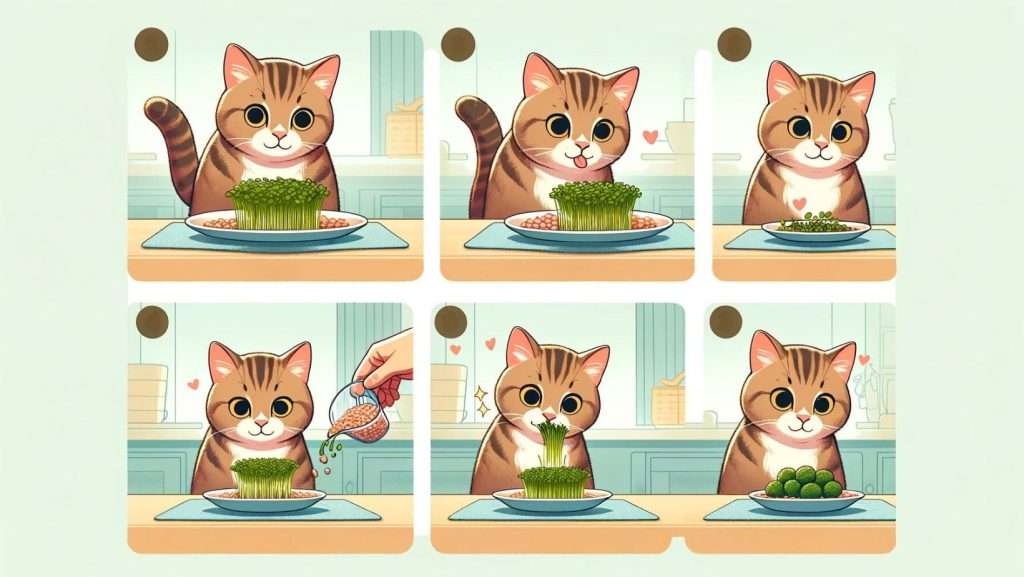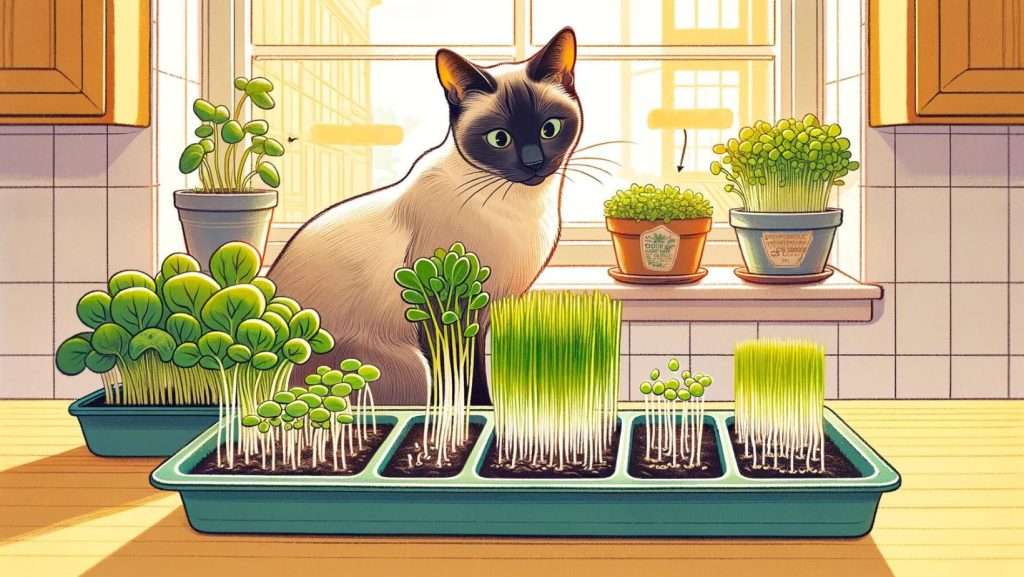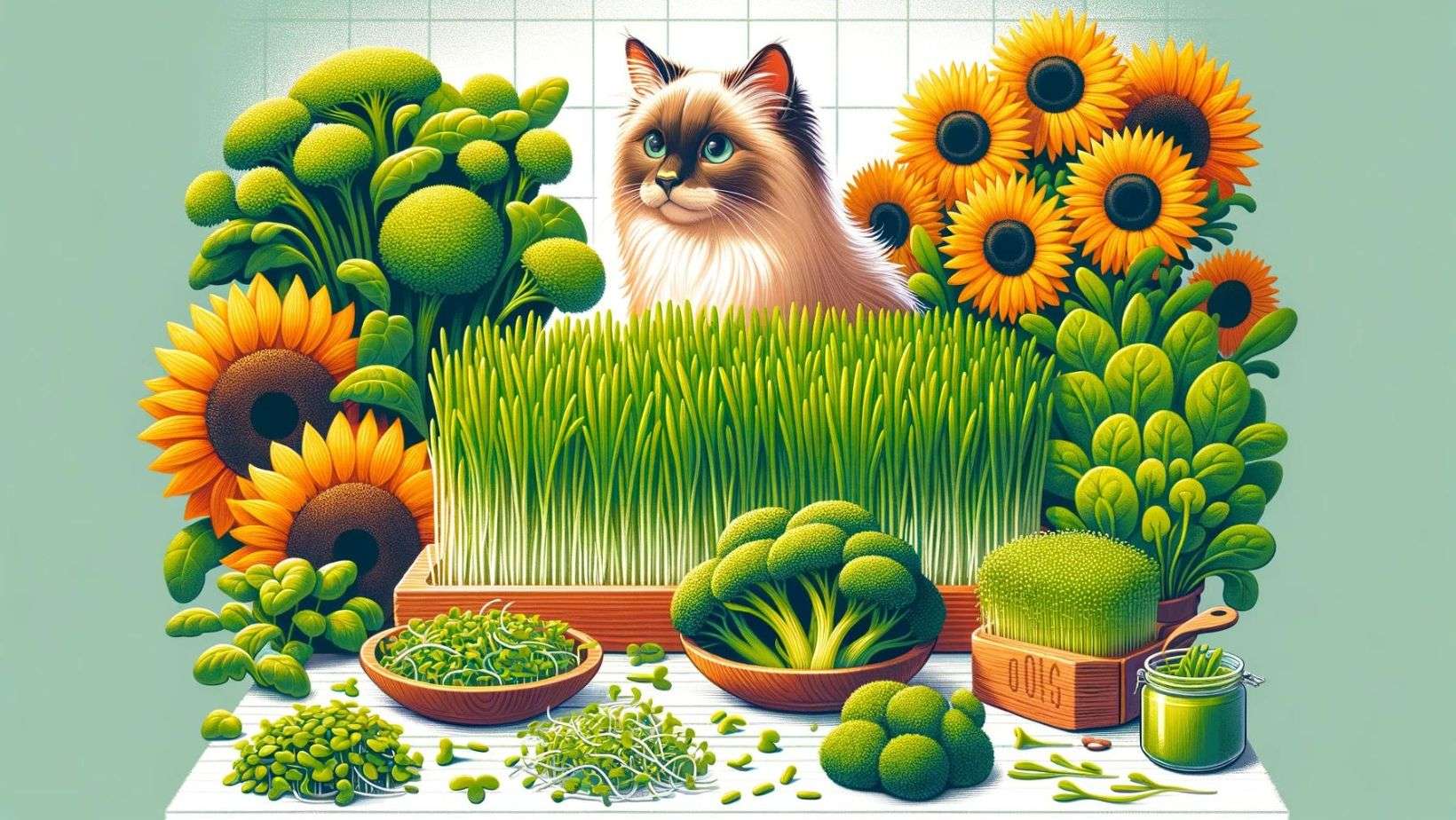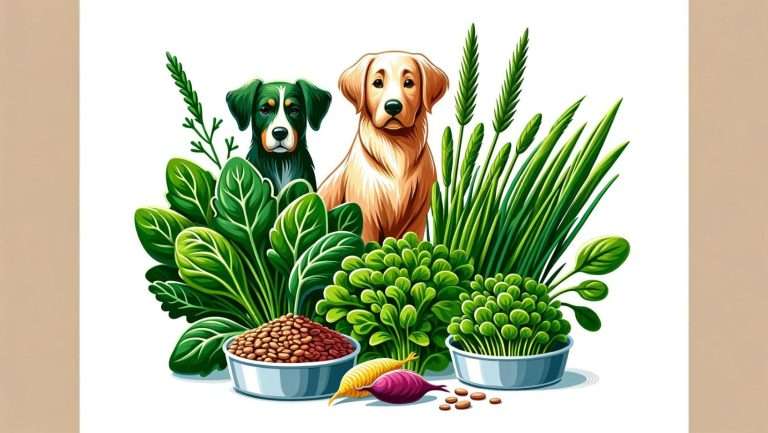Microgreens For Cats: Transforming Feline Diet and Health Naturally
Some of our posts on Microgreensguru.com contain affiliate links. If you click on an affiliate link and make a purchase, we may receive a commission. Clicking on an affiliate link that earns a commission does NOT result in additional charges or costs you extra. Earnings from affiliate links help keep this website running. See our full affiliate disclosure here.
If you’re a cat lover like me, you’re always on the lookout for ways to keep your feline friends happy and healthy. As a microgreens enthusiast, I couldn’t help but wonder: could these nutrient-packed mini-greens be the purr-fect addition to my cats’ diet?
Well, I did some digging (not in the litter box, I promise), and what I found might surprise you. Buckle up, kitty cats, because we’re about to explore the world of microgreens for our furry companions.
As with any change to your cat’s diet, consult with your veterinarian before adding microgreens to your little one’s meals. Microgreens are generally safe for cats and can provide them with valuable nutrients, but it’s always best to check with a professional first.
What Are Microgreens, Anyway?
First things first, let’s clarify what we’re dealing with here. Microgreens are the baby versions of vegetables, herbs, and other plants, typically harvested within 2 weeks of germination. These miniature greens pack a serious nutritional punch, often containing up to 40 times more vitamins and minerals than their mature counterparts. Talk about small but mighty!
Are Microgreens Safe for Cats?
Now, I know what you’re thinking: “That’s great and all, but are microgreens actually safe for my precious fur baby?” The good news is that, in general, microgreens are perfectly safe for cats to consume. However, as with any new food introduction, it’s always best to start small and monitor your cat’s reaction. Some cats may have sensitivities or allergies to certain plants, so it’s crucial to keep an eye out for any adverse effects.
The Best Microgreens for Your Feline Friend
So, which microgreens should you consider adding to your cat’s menu? Here are a few top contenders:
- Wheatgrass: Many cats are drawn to the tender texture and mild flavor of wheatgrass, making it a popular choice.
- Broccoli Microgreens: The crunchy texture and slightly sweet taste of broccoli microgreens can be enticing for cats.
- Kale Microgreens: Some cats enjoy the delicate leaves and earthy flavor of kale microgreens.
- Sunflower Microgreens: The nutty taste and unique texture of sunflower microgreens may pique your cat’s interest.
When selecting microgreens for your cat, consider factors such as texture, flavor, and aroma. Remember, every cat is unique, so it may take some experimentation to find the perfect match for your feline friend.
Nutritional Benefits of Microgreens for Cats
Now that we’ve covered the basics let’s dive into the juicy details: the nutritional benefits of microgreens for your cat. These tiny greens are packed with vitamins, minerals, and antioxidants that can support your cat’s overall health and well-being.
Some key nutritional benefits include:
- Boosted Immune System: Microgreens are rich in vitamins A, C, and E, which support immune function.
- Improved Digestion: The high fiber content in microgreens can aid in digestive health.
- Better Skin and Coat Health: Nutrients like vitamin E and zinc can promote a shiny coat and healthy skin.
To give you a better idea, check out this table showcasing the key nutrients in some popular microgreens:
| Microgreen | Key Nutrients |
| Broccoli | Vitamins A, C, K, and folate |
| Kale | Vitamins A, C, K, and calcium |
| Sunflower | Vitamin E, zinc, and selenium |
| Wheatgrass | Iron, calcium, and vitamins A, C, E |
Introducing Microgreens to Your Cat’s Diet
Now that you’re convinced of the incredible benefits of microgreens, you might be wondering how to introduce these tiny greens into your cat’s diet. Don’t worry; we’ve got you covered!
Here’s a step-by-step guide to help you successfully incorporate microgreens into your cat’s meals:
- Start small: Begin by offering a pinch of microgreens, either on their own or mixed into your cat’s regular food.
- Choose appealing greens: Select microgreens that are known to be palatable for cats, such as wheatgrass, broccoli, or kale.
- Monitor your cat’s reaction: Watch for any signs of digestive issues or disinterest in the microgreens.
- Gradually increase the amount: If your cat tolerates the microgreens well, slowly increase the quantity over time.
- Experiment with different varieties: Offer a range of microgreens to provide diverse nutrients and keep things interesting for your cat.
Remember, microgreens should be a supplement to your cat’s diet, not a replacement for their primary food. A good rule of thumb is to offer no more than a teaspoon of microgreens per day for an average-sized cat.

Microgreens and Digestive Health
If your cat is experiencing digestive issues, microgreens might be the secret weapon you’ve been looking for. The high fiber content and digestive enzymes found in microgreens can help support healthy digestion and alleviate common gastrointestinal problems.
Some ways microgreens can help with your cat’s digestive issues include:
- Promoting regular bowel movements: The fiber in microgreens can help regulate your cat’s bowel movements and prevent constipation.
- Soothing inflammation: Some microgreens, such as wheatgrass, contain anti-inflammatory properties that can help reduce inflammation in the digestive tract.
Microgreens that may be particularly helpful for cats with digestive issues include:
| Microgreen | Digestive Benefits |
| Wheatgrass | Anti-inflammatory, high in fiber |
| Broccoli | Contains sulforaphane, which supports gut health |
| Kale | Rich in fiber and antioxidants |
| Sunflower | High in fiber and digestive enzymes |
Growing Your Own Microgreens for Your Cat
If you’re a DIY kind of pet parent, you might be excited to learn that you can grow your own microgreens for your cat. Not only is this a fun and rewarding hobby, but it also allows you to control the growing conditions and ensure that your cat is getting the freshest, most nutrient-dense greens possible.
To start growing microgreens for your cat, you’ll need:
- Shallow trays
- Organic potting soil
- Microgreen seeds (cat-safe varieties like wheatgrass, broccoli, or kale)
- A spray bottle for watering
Simply fill the trays with soil, sprinkle the seeds evenly, and gently press them into the soil. Mist the soil with water and cover the trays with a lid or plastic wrap to retain moisture. Once the seeds sprout, remove the cover and place the trays in a sunny location or under grow lights. When the microgreens are 2-3 inches tall, carefully cut them just above the soil line and offer them to your cat.

Catnip Microgreens: A Feline Favorite
While we’re on the topic of microgreens, let’s not forget about the ultimate feline favorite: catnip! Did you know that you can grow catnip microgreens for your cat? These tiny greens pack all the aromatic punch of mature catnip plants and can provide your cat with a stimulating and enjoyable treat.
To grow catnip microgreens, follow the same steps as outlined above, but use catnip seeds instead. Once the microgreens are ready to harvest, sprinkle a small amount on your cat’s toys or scratching post, or offer them as a special treat.
Keep in mind that not all cats respond to catnip, and some may experience an initial burst of energy followed by relaxation. As with any new treat, introduce catnip microgreens slowly and monitor your cat’s reaction.
Frequently Asked Questions About Microgreens for Cats
- Can microgreens replace my cat’s regular diet? No, microgreens should be offered as a supplement to your cat’s balanced diet, not as a replacement for their primary food.
- How much microgreens should I feed my cat? A general guideline is to offer no more than a teaspoon of microgreens per day for an average-sized cat. Start with smaller amounts and gradually increase as tolerated.
- Are there any microgreens that are toxic to cats? Yes, some microgreens to avoid include onion, garlic, chive, and tomato microgreens, as well as any microgreens grown from plants known to be toxic to cats, such as lilies, nightshades, rhubarb, and avocado.
- Can microgreens help with my cat’s skin and coat health? Yes, microgreens contain nutrients like vitamin E, zinc, and biotin that can support healthy skin and a shiny coat. Consistently incorporating a variety of microgreens into your cat’s diet can provide a steady supply of these beneficial nutrients.

Key Takeaways
- Microgreens are a safe and nutritious supplement to your cat’s diet when introduced gradually and in moderation.
- Popular cat-friendly microgreens include wheatgrass, broccoli, kale, and sunflower microgreens.
- Microgreens offer numerous health benefits for cats, such as boosting the immune system, improving digestion, and promoting healthy skin and coat.
- You can easily grow your own microgreens for your cat at home using shallow trays, organic potting soil, and cat-safe microgreen seeds.
- Catnip microgreens are a special treat that many cats enjoy, but should be offered in moderation.
So there you have it, folks! You’re now equipped with all the knowledge you need to embark on the exciting journey of introducing microgreens into your cat’s diet. Your feline friend will thank you for the delicious and nutritious addition to their meals, and you can feel good knowing that you’re supporting their overall health and well-being.
Remember, every cat is unique, so be patient and pay attention to your cat’s preferences and reactions. With a little experimentation and a lot of love, you’ll find the perfect microgreen mix for your furry companion.
Happy growing, and may your cats be as healthy and happy as they are adorable!

Cal Hewitt is the Founder and Lead Cultivator at Microgreens Guru, a website dedicated to empowering individuals to grow, consume, and potentially sell nutrient-dense microgreens. With 5 years of hands-on experience in microgreens cultivation, Cal brings a unique analytical perspective to the world of urban agriculture. He specializes in optimizing growth techniques for various microgreen varieties, while also focusing on sustainable and cost-effective growing methods. Cal’s passion for microgreens, ignited by a personal health journey, drives him to continuously explore and share innovative approaches to microgreens cultivation. His practical experience, combined with his commitment to education through his website and upcoming book, ensures that Microgreens Guru remains a valuable resource for both novice and experienced growers alike.








